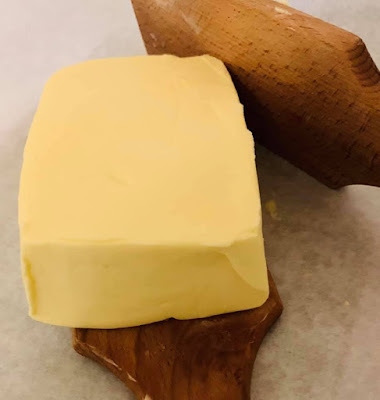Probiotic (cultured) Butter Recipe - Instant Pot / Yogurt Maker or Oven
Many butter recipes today are made by simply churning, or in modern day terms "whisking/blending" double or thick cream in a food processor until we get butter.
Great for a quick fix, but historically this isn't how butter was made.
Instead the cream was skimmed from the top of raw milk over a number of days to collect enough. It was then left at room temperature for a day or so until it "clabbered" or soured. This is when natural microbes and yeasts in the air colonise the raw milk alongside the bacteria that already resides there, the cream becomes thick and tangy and in effect you've created the original "sour cream".
The first time I made this it was a warm summer and I did indeed clabber the milk traditionally. However when I tried again in winter the results were less successful, Google suggests clabbering dairy is indeed less predictable - particularly when temperatures are changing (thank you British weather) and less than optimal.
Fortunately there's a solution! Use a stable culture and away you go...


Great for a quick fix, but historically this isn't how butter was made.
Instead the cream was skimmed from the top of raw milk over a number of days to collect enough. It was then left at room temperature for a day or so until it "clabbered" or soured. This is when natural microbes and yeasts in the air colonise the raw milk alongside the bacteria that already resides there, the cream becomes thick and tangy and in effect you've created the original "sour cream".
The first time I made this it was a warm summer and I did indeed clabber the milk traditionally. However when I tried again in winter the results were less successful, Google suggests clabbering dairy is indeed less predictable - particularly when temperatures are changing (thank you British weather) and less than optimal.
Fortunately there's a solution! Use a stable culture and away you go...

Probiotic (cultured) Butter
Fool-proof, glorious, deliciously smooth butter.
ingredients:
- Three teaspoons of live yogurt in a jug.I make mine using this as the yogurt is scrummy and so the rest is eaten, but you can use a store bought live yogurt or any other starter culture made into yogurt if you're trying to select/avoid specific strains.
- 1 litre double/thick creamYou can use raw if you can get it, pasteurised is also fine as we're going to add bacteria anyway - I've used both and the result is comparable. For this particular batch I used Sainsbury's Organic x 3 and a bit as they were on special offer.
instructions
Instant Pot Users
- Pour the cream into the inner pot, leave off the lid and press yogurt. Press adjust until it says "boil"
- Heat the milk until just warm, think newborn baby bath temperature! Keep an eye on it and stir regularly, it only takes a couple of minutes
- Switch the IP off, lift up the inner pot and swirl for a few moments before putting back (so the temperature stops rising)
- Pour one cup of the cream into the jug with the yogurt and whisk well. Add this back into the IP with the rest of the cream
- Add lid, press yogurt, then adjust until it says "Low". Set it for 12 hours
Pan/Oven
- Pour cream into a heavy bottomed pan and heat the milk until just warm, think newborn baby bath temperature! Keep an eye on it and stir regularly, it only takes a couple of minutes
- Remove from the heat and pour one cup or so into the jug with the yogurt
- Pour the rest into the vessel you plan to use (either yogurt maker or a pan/pot with a lid)
- Whisk the yogurt and cream well, then add to the rest of the cream
- Set your yogurt maker for 12 hours, or wrap in a towel and place in an oven with the light on (no heat)
After 12 hours
- Check your cream. It should be very thick/set and golden. If it's cooler or your starter yogurt has less bacteria, it may take up to 18 hours
- Proceed as normal making butter, either with your food processor/blender/mixer or by hand - it takes 3/4 minutes in the vitamix. You can melt this to make traditional ghee if you fancy too.

NOTES:
The buttermilk you collect from this recipe is called "Chaas", a probiotic drink popular across the Indian subcontinent (although it can also be the buttermilk from yogurt or from standard butter making); it can be drunk plain, or with added herbs and spices such as cumin, black pepper and mint. You can also use it in baking - scones and breads are delicious, it can be added to smoothies or you can use it to soak things like legumes (as you would whey).
AnalyticalArmadillo 2018

Appreciating the persistence you put into your blog and the detailed information you provide. Keep up the good work.
ReplyDeletesyarikat bekas biskut raya di malaysia
custom packaging supplier malaysia
ice cream tub supplier malaysia